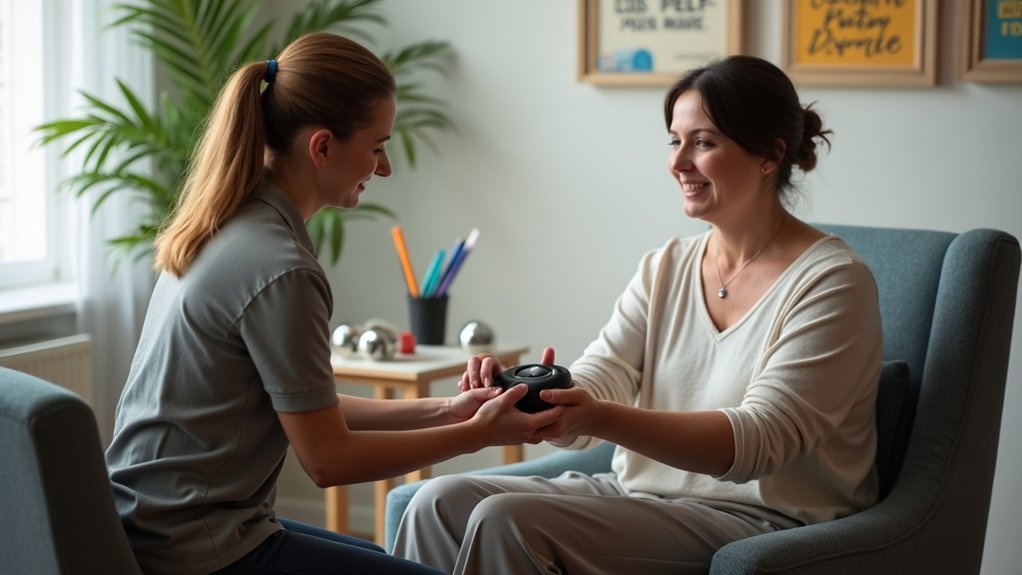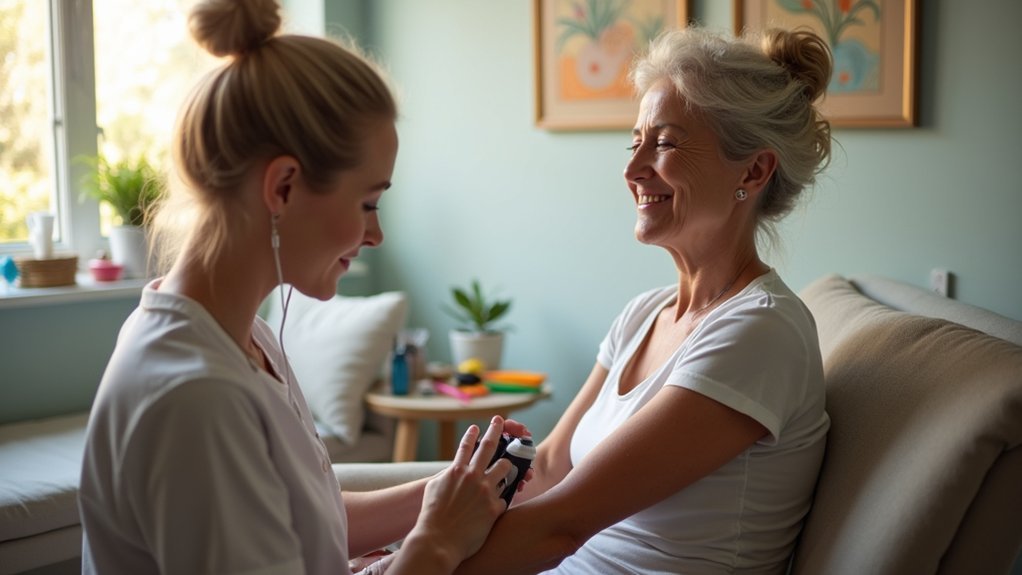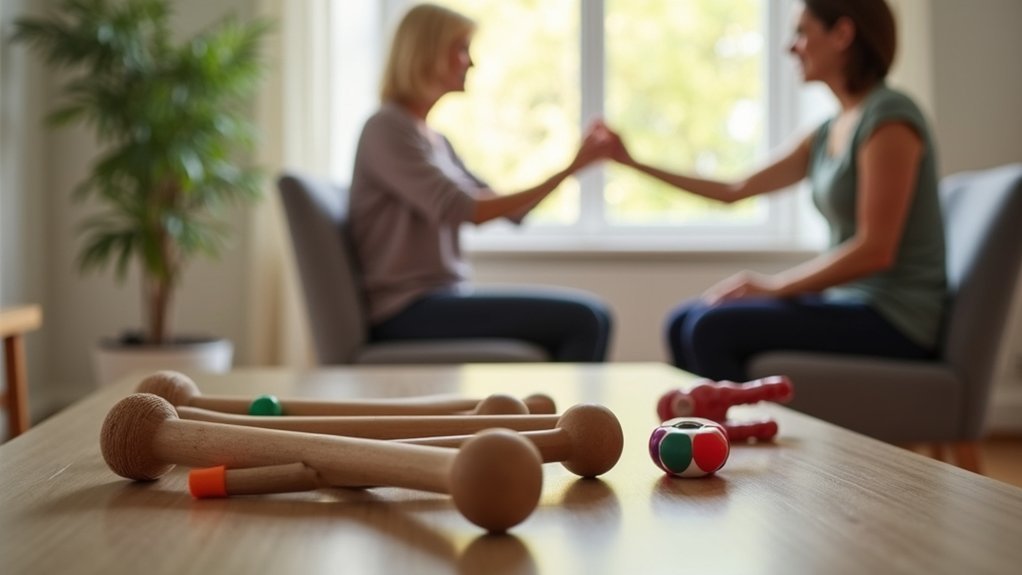Percussion therapy can boost your stroke recovery by reducing spasticity and enhancing muscle awareness. Start with the lowest intensity setting and use proper attachments for different muscle groups. Apply gentle pressure for 30-60 seconds in circular motions before traditional rehab exercises. Track your progress with a detailed log and adjust as needed. Always work with your therapist to integrate percussion effectively. These proven techniques will transform your rehabilitation journey when properly implemented.
7 Tips: Percussion Therapy For Stroke Recovery

Spasticity and sensory loss following a stroke can greatly impact recovery, which is where percussion therapy offers valuable benefits.
Percussion therapy provides essential sensory feedback that can help overcome post-stroke spasticity and sensation challenges.
When you’re experiencing muscle tightness or decreased sensation, massage guns can help desensitize affected muscles and improve your body’s tolerance to stretching.
You’ll want to start with the lowest intensity setting to gauge your response. While you can’t know for sure how your body will react initially, gradually increasing the speed as you build tolerance is recommended.
Apply the device to muscles experiencing spasticity, allowing the vibrations to provide essential sensory input to your brain.
This therapy works best when combined with your traditional rehabilitation exercises. The added sensory feedback can enhance muscle activation and awareness in limbs with diminished sensation, potentially accelerating your recovery progress.
Understanding Spasticity and Muscle Response to Percussion
Spasticity after stroke creates a hyperactive stretch reflex, making your muscles tighten involuntarily when stretched too quickly.
Your spastic muscles will respond differently to percussion than normal muscles, often requiring a gentler approach with gradually increasing intensity.
You’ll need to experiment with percussion settings while monitoring your muscle response, as the right intensity can help desensitize the hyperactive reflex without triggering more spasms.
Spasticity Mechanisms Explained
Following a stroke, your brain’s communication with muscles becomes disrupted, which results in the challenging condition known as spasticity. This neurological issue causes your muscles to receive incorrect signals, leading to abnormal stiffness and involuntary contractions.
When your brain suffers damage from a stroke, the delicate balance between excitatory and inhibitory signals becomes compromised. Your muscles then remain in a state of heightened tension, making movement difficult and sometimes painful. This hypertonicity occurs because your nervous system can’t properly regulate muscle tone anymore.
Percussion therapy works by sending rapid mechanical pulses to these tense muscles, effectively “resetting” their sensory feedback mechanisms.
Your spastic muscles gradually become desensitized to the stimuli that trigger contractions, potentially improving your limb’s tolerance to stretching and facilitating more natural movement patterns.
Percussion Adaptation Process
When your muscles encounter percussion therapy for the first time, they typically respond with a protective tension that gradually diminishes through an adaptation process.
For stroke survivors with spasticity, this initial response is heightened, making a slow introduction essential. Start with low intensity to allow your overactive muscles to adjust and avoid triggering involuntary contractions.
Regular percussion sessions can desensitize your muscles, improving their tolerance to stretching during rehabilitation exercises.
You’ll likely notice enhanced sensory awareness in affected limbs as treatment progresses.
- Begin with brief 30-second sessions on each muscle group
- Watch for decreased muscle stiffness as adaptation occurs
- Gradually increase intensity only when your body shows positive responses
This progressive approach helps transform percussion therapy into an effective tool for managing spasticity and enhancing mobility.
Selecting the Right Massage Gun for Neurological Recovery

Although the market offers numerous massage gun options, choosing the appropriate device for stroke recovery requires careful consideration of specific features.
Look for models with adjustable speeds and intensity levels that can be customized to your comfort and tolerance needs.
Adjustable speed options provide the personalized comfort control essential for effective stroke rehabilitation therapy.
Select devices with multiple interchangeable heads to effectively target different muscle groups during your rehabilitation journey.
A lightweight, portable design is essential, ensuring you can easily handle the massage gun in various settings.
Don’t overlook the importance of quiet operation, especially if you’re sensitive to noise during therapy sessions.
Whenever possible, prioritize massage guns developed with healthcare professional input, as these models are more likely to address the specific rehabilitation requirements for stroke recovery.
These carefully chosen features will greatly enhance your percussion therapy effectiveness.
Proper Technique: How to Apply Percussion to Affected Areas
Mastering the correct application technique is essential for maximizing the benefits of percussion therapy in stroke recovery.
Begin with the lowest speed setting to assess tolerance before gradually increasing intensity. Select the appropriate attachment—flat heads for larger muscle groups and pointed tips for targeted relief in specific areas of spasticity.
Apply the device to each muscle group for 30-60 seconds, moving in slow, gentle circular or linear patterns. Always monitor your patient’s response and adjust accordingly to prevent discomfort or increased spasticity.
- Focus primarily on areas with limited range of motion or noticeable muscle stiffness
- Allow the massage gun to work systematically through affected limbs, promoting blood flow
- Maintain consistent pressure but avoid pressing too hard—let the percussion action do the work
Gradually Building Tolerance Through Structured Sessions

Since many stroke patients initially find percussion therapy intense, developing tolerance requires a methodical approach. Always start at the lowest speed setting, allowing your body to adjust before gradually increasing intensity based on your comfort level.
Keep sessions structured between 5-15 minutes, focusing on specific muscle groups rather than treating the entire body at once. Include regular breaks during therapy to prevent overstimulation and give muscles time to recover.
Watch for signs of discomfort or increased spasticity—these are signals to adjust your approach. If you notice negative reactions, reduce session duration or frequency temporarily.
Consistency is key to building endurance. Aim for multiple sessions per week on a regular schedule. This structured approach helps your body adapt progressively, making percussion therapy increasingly beneficial for your recovery journey.
Combining Percussion Therapy With Traditional Rehabilitation Exercises
You’ll see significant improvements when you gradually introduce percussion therapy during familiar rehabilitation exercises under professional guidance.
Start by applying light percussion to targeted muscle groups while performing basic movements, such as assisted reaches or supported standing exercises.
Your therapist can teach you specific techniques that combine traditional rehabilitation principles with percussion therapy’s benefits, creating a more effective recovery approach that addresses both mobility and neurological adaptation.
Progressive Exercise Integration
The integration of percussion therapy with traditional rehabilitation exercises creates a powerful synergy for stroke recovery patients.
You’ll achieve better results by gradually introducing percussion massage before your regular rehab routines. Start with the lowest speed setting on the massage gun, then assess your tolerance and response before increasing intensity.
- Apply percussion therapy to spastic muscles for 1-2 minutes before attempting range-of-motion exercises
- Use the massage gun to stimulate areas with reduced sensory awareness, enhancing your brain’s connection to affected limbs
- Incorporate brief percussion sessions between exercise sets to maintain muscle relaxation and improve movement quality
This combined approach helps desensitize overactive muscles, promotes blood flow, and prepares your body for more effective rehabilitation movements, ultimately accelerating your recovery progress.
Therapist-Guided Techniques
Working closely with a trained rehabilitation therapist maximizes the benefits of percussion therapy for stroke recovery. Your therapist will customize percussion intensity and speed to your comfort level while targeting specific muscle groups that need attention.
| Technique | Benefit |
|---|---|
| Pre-exercise percussion | Reduces muscle spasticity before traditional exercises |
| Sensory input application | Enhances limb awareness for better movement control |
| Graduated intensity | Adapts to your progress and comfort thresholds |
| Integrated approach | Combines percussion with traditional rehabilitation exercises |
You’ll notice improved muscle activation during therapy sessions as percussion provides sensory feedback to your brain. This multidisciplinary approach helps overcome reduced limb awareness while potentially improving your mobility and independence. The combination of percussion therapy with traditional exercises creates a more engaging and effective rehabilitation experience.
Monitoring Progress and Adjusting Your Approach
Successful percussion therapy requires consistent monitoring and thoughtful adjustments throughout the stroke recovery journey. Keep a detailed log of each session, recording duration, intensity, and areas treated to track patterns in your recovery.
Regularly assess your response to treatment, noting improvements in mobility, pain levels, and muscle tension. Start with the lowest intensity setting and gradually adjust based on your tolerance.
Don’t hesitate to modify your approach as you progress—what works initially may need refinement later. Incorporate feedback from your rehabilitation team to guarantee percussion therapy complements your overall treatment plan.
- Track mood and stress levels—psychological improvements often signal effective therapy
- Document specific mobility gains to maintain motivation
- Collaborate with therapists to align percussion therapy with rehabilitation goals
Frequently Asked Questions
How Long Does It Take for the Brain to Settle After a Stroke?
Your brain begins settling within days after a stroke, but full recovery can take months or years. You’ll often see significant improvements in the first 3-6 months through neuroplasticity and rehabilitation efforts.
What Is the Best Massage for Stroke Recovery?
You’ll benefit most from gentle, progressive massage techniques that target affected areas. Start with light effleurage and gradually include deeper strokes as tolerance improves. Always consult your physical therapist for personalized recommendations.
How to Train the Brain After a Stroke?
To train your brain after a stroke, engage in consistent repetitive exercises, use sensory stimulation, practice cognitive tasks, incorporate visual cues, and remain patient—neuroplasticity works gradually through your dedicated effort and consistent practice.
What Happens in the First 3 Days After a Stroke?
In the first 3 days after a stroke, you’ll experience critical brain changes including inflammation and repair. You’ll likely begin rehabilitation within 24-48 hours, while doctors monitor you for complications and assess your physical symptoms.
In Summary
Percussion therapy can be a valuable tool in your stroke recovery journey. You’ll find it’s most effective when properly integrated with your rehabilitation program. Remember to start slowly, follow proper techniques, and adjust as needed based on your body’s response. By consistently applying these seven tips, you’re taking proactive steps toward improved mobility and reduced spasticity. Always consult your healthcare provider about incorporating new therapies into your recovery plan.





Leave a Reply